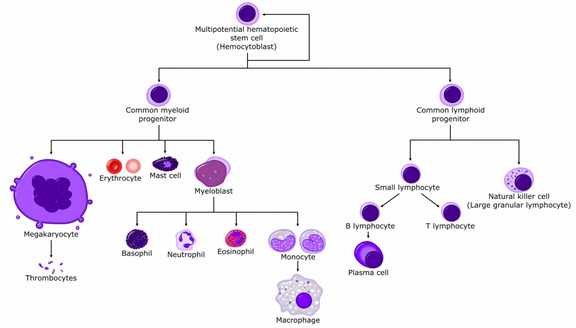PNAS:重新绘制造血细胞图谱
2012-02-04 MedSci MedSci原创
造血干细胞产生两种主要的祖细胞系:髓样祖细胞(myeloid progenitor)和淋巴样祖细胞(lymphoid progenitor)。图片来自:Regenerative Medicine. Department of Health and Human Services. Chapter 2: Bone Marrow (Hematopoietic) Stem Cells. August 20

造血干细胞产生两种主要的祖细胞系:髓样祖细胞(myeloid progenitor)和淋巴样祖细胞(lymphoid progenitor)。图片来自:Regenerative Medicine. Department of Health and Human Services. Chapter 2: Bone Marrow (Hematopoietic) Stem Cells. August 2006.
来自澳大利亚沃尔特与伊丽莎-霍尔研究所(Walter and Eliza Hall Institute)的研究人员在研究血液系统中应对危机的细胞时得出一些令人吃惊的结论,从而重新描绘体内血细胞如何制造的“图谱”。这一发现可能对人们理解诸如骨髓增生性疾病(myeloproliferative disorder,它导致血细胞过量产生)之类的血液疾病和开发控制血细胞和凝血细胞如何产生的新方法有着广泛的影响。
该研究所癌症和血液学部门Ashley Ng博士和Maria Kauppi博士领导的研究小组研究了一部分血祖细胞和导致它们增殖和产生成熟血细胞的信号。2012年1月30日,他们的研究结果发表在PNAS期刊上。
Ng博士将血祖细胞描述为血液系统的“顶梁柱(heavy lifter)”。他说,“它们是血细胞中称作细胞因子的激素的作用靶标,其中Don Metcalf教授和同事们已经证实这些激素在调节血细胞产生中发挥着关键性作用。在遭受应激如流血时,在感染期间或者接受化疗之后,确实是血祖细胞通过替换丢失或受损的血细胞而作出反应。”
Kauppi博士说,研究小组特别对髓样祖细胞(myeloid progenitor cell)兴趣极大,因为这种细胞产生巨核细胞---一种产生凝血作用的血小板的骨髓细胞。她说,“我们使用一套这些祖细胞特异性的细胞表面标记,从而允许我们分离和描述这些细胞。”
研究人员吃惊地地发现人们曾认为只能产生巨核细胞的祖细胞也能够产生红细胞。
Ng博士说,“我们能够清晰地证实这些小鼠巨核细胞祖细胞在对诸如促血小板生成素(thrombopoietin)和促红细胞生成素(erythropoietin)之类的细胞因子作出反应之后产生巨核细胞或者红细胞,这是非常令人意料之外的。此外,我们发现人们以前认为只能制造嗜中性细胞(neutrophil)和单核细胞的其他祖细胞群体也能够制造红细胞和血小板。事实上,我们将不得不重新描绘骨髓中制造红细胞和血小板的图谱。”
Kauppi博士说,研究人员发现他们能够通过使用不同的细胞因子组合调节血祖细胞变成巨核细胞或者红细胞。她说,“如今我们正确地鉴定出主要细胞并且确定它们如何对涉及红细胞和血小板产生的细胞因子信号作出反应,这就为人们理解健康时和生病时如何影响这些祖细胞打下基础。比如,我们能够更好地理解遗传改变如何可能导致某种血液疾病的产生。”
Ng博士说,这些发现也将有助于研究人员发现能够控制血祖细胞的新方法。
Ng博士说,“这一研究是人们未来开发出治疗血液疾病患者的方法的第一步。当细胞制造过多时,如骨髓增生性疾病,人们可能通过限制血细胞产生来治疗疾病,或者当血液系统受损时,如癌症治疗或感染期间,促进血液产生来治疗疾病。” (生物谷:towersimper编译)
延伸阅读:
Nature:鉴定出产生培育造血干细胞微环境的细胞
Mol. Cell:SENP1蛋白在T细胞和B细胞发育中发挥关键性作用
Cell:血祖细胞接受微环境细胞和子血细胞信号维持平衡
Science:细胞内随机性竞争决定B细胞命运
Science:揭示B细胞不均等分裂产生抗体机制
Nat. Genet:发现造血干细胞分化关键性基因Dnmt3a
Nat. Genet:Dnmt3a抑制造血干细胞自我更新基因表达
Cell Stem Cell:揭示造血干细胞来源的秘密
Gene Dev.:麻省理工白头研究所首次发现长链非编码RNA阻止红细胞死亡
Characterization of thrombopoietin (TPO)-responsive progenitor cells in adult mouse bone marrow with in vivo megakaryocyte and erythroid potential
Ashley P. Ng, Maria Kauppi, Donald Metcalf, Ladina Di Rago, Craig D. Hyland, and Warren S. Alexander
Hematopoietic progenitor cells are the progeny of hematopoietic stem cells that coordinate the production of precise numbers of mature blood cells of diverse functional lineages. Identification of cell-surface antigen expression associated with hematopoietic lineage restriction has allowed prospective isolation of progenitor cells with defined hematopoietic potential. To clarify further the cellular origins of megakaryocyte commitment, we assessed the in vitro and in vivo megakaryocyte and platelet potential of defined progenitor populations in the adult mouse bone marrow. We show that megakaryocytes arise from CD150+ bipotential progenitors that display both platelet- and erythrocyte-producing potential in vivo and that can develop from the Flt3− fraction of the pregranulocyte-macrophage population. We define a bipotential erythroid-megakaryocyte progenitor population, the CD150+CD9loendoglinlo fraction of Lin−cKit+IL7 receptor alpha−FcγRII/IIIloSca1− cells, which contains the bulk of the megakaryocyte colony-forming capacity of the bone marrow, including bipotential megakaryocyte-erythroid colony-forming capacity, and can generate both erythrocytes and platelets efficiently in vivo. This fraction is distinct from the CD150+CD9hiendoglinlo fraction, which contains bipotential precursors with characteristics of increased megakaryocytic maturation, and the CD150+CD9loendoglinhi fraction, which contains erythroid lineage-committed cells. Finally, we demonstrate that bipotential erythroid-megakaryocyte progenitor and CD150+CD9hiendoglinlo cells are TPO-responsive and that the latter population specifically expands in the recovery from thrombocytopenia induced by anti-platelet serum.
本网站所有内容来源注明为“梅斯医学”或“MedSci原创”的文字、图片和音视频资料,版权均属于梅斯医学所有。非经授权,任何媒体、网站或个人不得转载,授权转载时须注明来源为“梅斯医学”。其它来源的文章系转载文章,或“梅斯号”自媒体发布的文章,仅系出于传递更多信息之目的,本站仅负责审核内容合规,其内容不代表本站立场,本站不负责内容的准确性和版权。如果存在侵权、或不希望被转载的媒体或个人可与我们联系,我们将立即进行删除处理。
在此留言










#PNAS#
47
#细胞图谱#
70
#血细胞#
67
#造血#
77
#造血细胞#
64